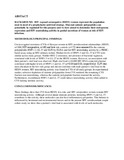| dc.description.abstract | BACKGROUND:
HIV exposed seronegative (HESN) women represent the population most in need of a prophylactic antiviral strategy. Mucosal cationic polypeptides can potentially be regulated for this purpose and we here aimed to determine their endogenous expression and HIV neutralizing activity in genital secretions of women at risk of HIV infection.
METHODOLOGY/PRINCIPAL FINDINGS:
Cervicovaginal secretions (CVS) of Kenyan women in HIV-serodiscordant relationships (HESN, n = 164; HIV seropositive, n = 60) and low-risk controls (n = 72) were assessed for the cationic polypeptides HNP1-3, LL-37 and SLPI by ELISA and for HIV neutralizing activity by a PBMC-based assay using an HIV primary isolate. Median levels of HNP1-3 and LL-37 in CVS were similar across study groups. Neither HSV-2 serostatus, nor presence of bacterial vaginosis, correlated with levels of HNP1-3 or LL-37 in the HESN women. However, an association with their partner's viral load was observed. High viral load (>10,000 HIV RNA copies/ml plasma) correlated with higher levels of HNP1-3 and LL-37 (p = 0.04 and 0.03, respectively). SLPI was most abundant in the low-risk group and did not correlate with male partner's viral load in the HESN women. HIV neutralizing activity was found in CVS of all study groups. In experimental studies, selective depletion of cationic polypeptides from CVS rendered the remaining CVS fraction non-neutralizing, whereas the cationic polypeptide fraction retained the activity. Furthermore, recombinant HNP1-3 and LL-37 could induce neutralizing activity when added to CVS lacking intrinsic activity.
CONCLUSIONS/SIGNIFICANCE:
These findings show that CVS from HESN, low-risk, and HIV seropositive women contain HIV neutralizing activity. Although several innate immune proteins, including HNP1-3 and LL-37, contribute to this activity these molecules can also have inflammatory properties. This balance is influenced by hormonal and environmental factors and in the present HIV serodiscordant couple cohort study we show that a partner's viral load is associated with levels of such molecules. | en |

